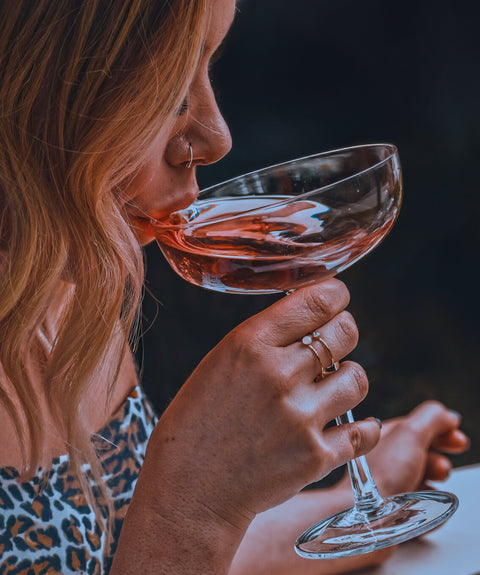(Yes, even that grape you think you hate).
Let’s kick off with a classic wine faux pas - “I don’t drink Chardonnay, but I love Chablis.”
Or in a similar vein… “I won’t touch Sauvignon Blanc, but pour me a glass of Sancerre and I’m happy.”
Sound familiar?
Because there is so much choice when it comes to wine, it's of course natural to try and classify the wines we like. Or don’t like.
But a common mistake that casual wine drinkers can make, is putting all the emphasis on a single factor. In this case, the grape alone.
But a vast number of factors influence what ends up in your glass. Grape variety, climate, vineyard practices, ageing, winemaking processes… the list goes on. The danger of creating such a narrow set of preferences, (i.e drinking from one single region), is that you miss out on some cracking wine. Much of which may still be to your taste.
Wine Is Complicated. (But That’s Half the Fun.)
Wine is essentially just fermented grape juice. But the art of winemaking goes much deeper.
Take barrel aging for example. It’s not just a question of whether it takes place or not. The type of oak used, whether the barrel is new or not, and even the level of toasting used to make the barrel, all have an impact on the final wine flavour. So adhering to broad statements like “I hate oaked whites” can be severely limiting.
Grapes: The Starting Point, Not the Whole Story
So how can we navigate our wine preferences in a less limiting way? The grape varietal is certainly a good place to start. It will shape certain fruit, floral and herbal notes. But remember, the same grape can produce wildly different wines. Take Syrah and Shiraz. They are genetically identical, but Syrah’s are fresher, medium bodied wines from the Rhone, impacted by the cool Northern wind. Australian Shiraz, usually grown in very warm climates, are typically full bodied and jammy.
It might be more useful to think in terms of aromatic vs non-aromatic grapes. Grouping in this way is more likely to accommodate personal preferences without limiting choice too much.
Aromatic grapes (e.g Gewürztraminer, Riesling, Torrontés) have pronounced fruit and floral flavours, like rose and lychee for Gewurztraminer. Some grapes are more aromatic than others, so it’s important to assess what level of aromatics suits you best.
Non-Aromatics (e.g Chardonnay, Pinot Gris, Chenin Blanc) are more reserved, and better suited to winemaking practices, like oak ageing or malolactic fermentation. These processes can have more influence on the wine's final appeal. If you’re convinced you hate Chardonnay, odds are it was a big, buttery number from California aged in new oak you weren’t so keen on. Hence your preference of Chablis - crisp, clean and unoaked. Same grape, but completely different.
Regional impact: Sauvignon Blanc vs. Sancerre
It’s a similar story with your regional Sauvignon Blancs. Sancerre has a flinty profile due to the unique soils of the region. While Marlborough Sauvignons are more tropical. Some can be quite vegetal. Same grape but very different result.
And that’s really the point. If you can figure out the specific trait you did or didn’t like - the ripe tropical fruit? The herbal kick? The strong oak? Then you can seek out better matching wines, rather than including or excluding a whole grape variety.
Region Isn’t a Guarantee Either
A wine’s region of origin can offer some consistent indicators of wine style, especially with old world wine regions. But there are also single regions that have a vast array of different climates, landscapes, soils and altitudes. And are therefore capable of producing wildly different types of wines.
Case in Point: Alentejo, Portugal
Wines here range from floral and elegant reds in the northern part near Lisbon; to big, bold, tannic beasts in the south. Same regional label, but very different styles due to the varying climatic conditions.
Another: Languedoc, France
Once upon a time, I avoided all wine from the Languedoc in South France. I’d had one too many ropey bottles. But then I found Minervois—a sub-region making earthy, fruit-forward reds that I now can’t get enough of. Lesson learned: don’t write off a region based on one dodgy bottle, especially when it’s a large region with lots of variation.
And Then There’s Quality
Even with a region as renowned and regulated as Champagne, you’re still going to get big differences in quality. Yes all Champagne must spend at least 15 months on its lees (those dead yeast cells), so you should be able to recognise those bready, brioche notes that Champagne is synonymous with.
But there are a number of other factors that can impact the quality. I’ll always remember a tiny producer there once telling me how he keeps all the best juice (the cuvee) for his own label fizz, whilst selling the lesser stuff to the premium champagne houses (no names mentioned). The fact they’re charging five times more, proves that price is not always a guarantee of quality.
Like me, you’ve probably had a bang-average Bordeaux from a French supermarket before. Prestige regions like Bourgogne (Burgundy) or Bordeaux might sound impressive, but they mean very little without the finer details: the sub-region, the vineyard, the vintage, the producer.
Without that info, you’re mostly just rolling the dice. Or, you end up paying a small fortune. And not everyone can afford a bottle of Domaine de la Romanée-Conti (Google it - the most expensive ever sold for a mere $558,000).
So, How Do You Drink Better Wine?
The answer I believe is simple, without solely relying on grapes and regions.
Be open-minded. Seek variety. Take recommendations.
Wine is supposed to be an adventure, not a safe space. The variety that makes wine so complicated and infuriating, is also the very same thing that makes wine so amazing and endless. The more you try, the more you’ll learn. And the more you learn, the better you’ll get at picking out what actually lights up your taste buds.
Restricting yourself to “only Italian reds” or “just crisp dry whites” is like going to a restaurant and only ordering chips. Yeah they probably taste good, and you know what you’re getting. But you’re missing out on some amazing wine.
Where to Start?
1. Follow Your Taste, Not Just the Grape
Love that crisp, citrusy Sancerre? Look for other wines with similar profiles. Look up the body, the acidity, and the flavour profile. Look at wines made in similar climates (or even soils) from different grapes. Try an aromatic white from Alto Adige in North Italy for example.
2. Don’t Just Shop by Region
Consider how the grapes have been treated in the vineyard and winery. What processes have taken place? Or is the winemaker's philosophy more minimal in approach? If you dislike those big bold Chardonnays, look for unoaked versions. If you do like Champagne, try other traditional method sparklings from other regions that have been made in a similar way.
3. Trust the Experts
Even if you’re a seasoned wine drinker, wine recommendations from pros who’ve actually tried the wine are worth their weight in grapes. Without tasting you’ll never know for sure, and good recommendations usually assure quality, and can lead you to bottles you’d never pick on your own.
4. Go Off the Beaten Track
There’s amazing value to be found in lesser-known grapes and regions. A brilliant red from Romania will often beat a mediocre Rioja at the same price. No brand tax, no BS.
Final Word: Embrace the Chaos
Wine is complex, contradictory, and occasionally pretentious. But it’s also one of the most rewarding things to explore, especially when you find that new bottle that you really love.
So ditch the grape snobbery. Be curious. Drink boldly.
And if you still want to say you hate Chardonnay - at least make sure you’ve tried more than one.
Like what you’ve read? At Wildcase, we seek out unique wines you may never have tried before. We embrace different. Browse our range of wines, or join the club.





